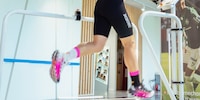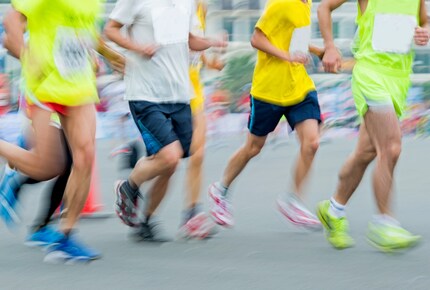
Background information
Why a running analysis was worthwhile for me – and might be something for you too
by Siri Schubert

Super shoes make for superb race times, right? The top marathon times of pro athletes have indeed improved since the introduction of cushioned, carbon-reinforced shoes. Biomechanics professor Dr Steffen Willwacher explains if and how you can incorporate these top-class running shoes into your training and races.
A hype has arisen around super shoes – that is, running shoes with carbon plates and thick cushioning. Just a few years ago, they were almost exclusively reserved for the international elite. These days, amateur athletes are increasingly sporting them. Super shoes are designed to make you faster and improve your running economy. And who wouldn’t like a little extra speed? I certainly would!
But what’s true and what’s mere hearsay? To get to the bottom of it, I met with biomechanics professor and former decathlete Dr Steffen Willwacher at the Zurich Forum for Applied Sport Sciences, organised by Swissbiomechanics (linked pages in German).
Since their debut around eight years ago, super shoes, i.e. shoes with specially cushioned midsoles and carbon plates, have been spreading rapidly in professional running. Recently, they’ve also made their way to recreational sports. Is this a good thing?
Steffen Willwacher: Ultimately, new technology not only makes you faster, but also makes things more fun, and if you can improve your best time, it’s motivating. In other words, it gives you a nice goal to run towards. This is why wearing running shoes that allow you to run faster can be a good idea.
But it’s surely not as simple as that. What should runners pay particular attention to when switching to super shoes?
Super shoes are built very differently from conventional running shoes. With that, they change the forces acting on the body. For example, some bones in the foot are loaded differently. In addition, tendons such as the Achilles tendon and some muscles may be subjected to much greater strain. In concrete terms, this means that if you switch all your training to super shoes from one day to the next, you run a high risk of sustaining an overuse injury.

What are the most common injuries?
So far, there are no scientific findings on this, but mainly experience reports. The problems seem to occur mainly in the area of the foot bones, particularly the navicular bone, a tarsal bone on the side of the big toe. There are also reports of increased pain in the Achilles tendon. Others complain of problems with the hip muscles and the backs of their thighs. To a certain extent, it depends on what type of runner you are and which structures your running style puts particular strain on. It’s impossible to generalise.
How can you prevent such issues?
If you want to run in super shoes in the long term, you should start by slowly and gradually increasing your training in these shoes, making sure to always listen to your body. This means perhaps first going for a walk in the shoes to get used to the different load. After that, you can run a short training session in them. Continue the rest of your training in your usual shoes, ideally in several pairs you keep on rotation. With time, you can gradually increase the volume and intensity of training in your super shoes. It can take several weeks or months – easily up to half a year – to get used to them. If you want to switch over your training entirely, you should really take your time doing so.
So lacing up your super shoes only on race day isn’t a good idea?
In some cases, it’s actually not the worst idea. If you see super shoes purely as a competition footwear and only use them then, it can work. Of course, it still makes sense to wear the shoes beforehand from time to time to get used to them. But you can skip total adaptation and the necessary adjustment phase to achieve it. Initial studies show that it’s possible to exploit the potential of the shoes relatively well in competition without having been accustomed to them for a long time beforehand.
What does a short acclimatisation period look like?
It always depends on the individual. Every person will react differently. You could do a test run to see how you cope with the shoes. You might notice areas of your feet, calves or knees that are a little more sore than usual. If this is the case, listen to your body and maybe don’t run the half marathon in those shoes after all. But if this doesn’t cause any problems, you could actually use the shoes for these specific situations.
This would make the shoes something of a race day miracle tool.
Yes, you could say that, as it’s been clearly proved that super shoes can create a time advantage of up to four per cent. And they last longer. Though one disadvantage of super shoes is that they lose their super cushioning properties relatively quickly. At the elite level, runners will finish a marathon in a specific pair of shoes and then shelve them. With a price tag of several hundred francs or euros, this simply isn’t a realistic option for most amateur runners.

The advantage of super shoes at the elite level is clear: speed. But can all runners benefit equally?
We’ve seen a clear effect among professional runners. Marathon and half-marathon times have become faster and faster since Nike introduced its super shoes in 2016. The effect is greater at faster running speeds and, according to the data, women appear to benefit more. Among the non-elite, we see greater variability. This means that in the leisure sector, some improve their times thanks to the super shoes, while others see little improvement or even worse times.
How do super shoes create these improvements?
The cushioning and stiffening provided by carbon improves running economy. Put simply, they give you more spring. This reduces the metabolic costs, i.e. the energy you have to expend to cover a certain distance. I sometimes jokingly say that the super shoes are not for people who want to lose weight by running, because they burn fewer calories over the same distance.
Motivation matters. If you’re aiming for fitness and health, you’ll reach for different shoes than the ambitious athlete who wants to improve their personal best time or might even be aiming to go pro.
Precisely. If you want to get faster, super shoes can be motivating and by running more and aiming for a goal, your fitness will also improve. But if you go for a casual jog twice a week, your goal might be to stay injury-free and wear shoes that feel comfortable. In the latter case, super shoes, or advanced footwear technology (AFT) as it’s known in the trade, are not the right choice.
Thank you for the interesting interview and the insights into this new running shoe technology.
Research diver, outdoor guide and SUP instructor – I love being in, on and around water. Lakes, rivers and the ocean are my playgrounds. For a change of perspective, I look at the world from above while trail running or flying drones.
Interesting facts about products, behind-the-scenes looks at manufacturers and deep-dives on interesting people.
Show all
Background information
by Siri Schubert

Background information
by Siri Schubert

Background information
by Stephanie Vinzens